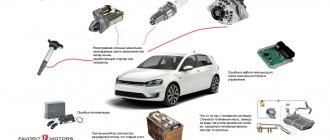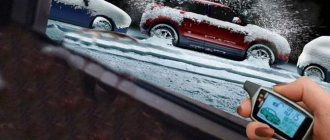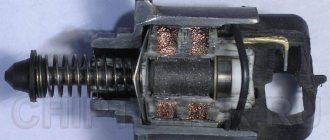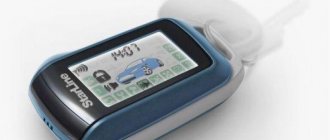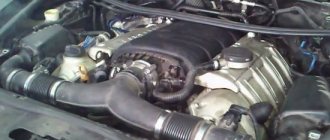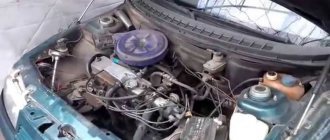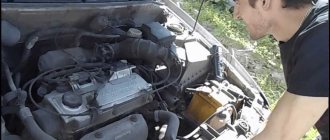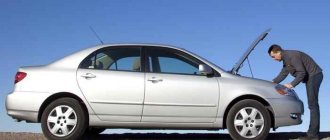It happens that you buy a new car, and at first it starts up great. Then something wrong happens - everything doesn’t work. The problem when a car stalls while driving and does not start is one of the most discussed problems among motorists today. Five most common reasons:
- lack of fuel;
- pump failure;
- filter contamination;
- ignition failure;
- sensor malfunction.
Some of them can be easily fixed by an experienced driver with his own hands, but some problems can only be solved with the help of repair shop employees.
Engine operating conditions
Modern cars are complex, well-thought-out mechanisms, where all structural elements are complemented or reinforced. For stable operation of the motor, the following parameters must be observed:
- Sufficient fuel and air supply. If the proportions are violated, the engine may become unbalanced and become unstable.
- Correct spark timing for gasoline internal combustion engines. If the ignition system is not calibrated correctly, the spark will fire late or early, which will significantly reduce engine performance.
- Normal compression in the cylinders. When the working chamber is depressurized, the energy released after fuel combustion goes into the crankcase, where it is dissipated. This effect causes the fuel supply system to supply more mixture and consume it in larger quantities. Additionally, this may cause interruptions in the operation of the internal combustion engine.
- Normal condition of internal parts and mechanisms. If the cylinder-piston group is worn out or damaged, it can cause the unit to become unbalanced, stop abruptly, and even jam.
If all conditions are met, the power plant will operate in standby mode. For a sudden stop, the occurrence of even one of the described factors is sufficient.
Conclusion
If you suddenly stop on the highway, there is no need to panic. You can most often find the cause of the stop and eliminate it yourself. This article will help you do this without any problems.
Monitor and maintain your vehicle promptly. Don't let your car fall into disrepair and then it won't let you down either. Visit only trusted car services.
Subscribe to our YandexZen
3 479
Typical parameters
Each engine has its own parameters that differ from the calibration of analogues. Each motor is characterized by a certain configuration of auxiliary equipment and its main parts.
Compression ratio and compression
Existing concepts have become overgrown with myths and misconceptions among car enthusiasts. What is known for certain is that compression affects starting the engine and maintaining its operating speed at a given level, with minimal fuel consumption.
The compression ratio, in principle, cannot influence the sudden stop of the power plant. The indicator characterizes the ratio of the volume of space above the piston at TDC and BDC. The greater the difference, the better, but not always.
Fuel supply
In modern internal combustion engines, proper fuel supply is the most important factor in their normal functioning. The injector design is more complex than an outdated carburetor. Thus, in classic engines, minor disturbances in the intake system had a minimal impact on performance.
The injectors are sensitive to minimal changes in tattooing. Thus, a simple failure or blockage of several injectors can shut down the internal combustion engine in 2-3 seconds.
Control unit and sensors
The next important parameter is the correct programming of the ECU and sensor response. The point is this:
- The sensors transmit information to the ECM about the state of the internal combustion engine at each moment in time.
- Control units read data and, depending on the impulses, send commands to electronic devices, thereby stabilizing the engine.
If the procedure is violated (wear of sensors, severe battery discharge, mechanical damage to electronics), sudden failures can occur, which often causes installation failure.
Timing
The next important parameter is responsible for the proper circulation of gases in the combustion chamber. Setting up the valve system and calibrating them guarantees timely exhaust removal and correct filling with a new portion of the fuel mixture.
If the gas distribution mechanism is not calibrated correctly, the car may stall at full speed or may not start.
Sparking
The next important parameter is directly responsible for the ignition of the mixture. The correct moment of spark formation is established by calibrating the distributor or ECM. If the device malfunctions, the entire system does not work correctly and critical interruptions in engine operation occur, which can cause its sudden failure.
What to do
To understand what actually happened to the car, that its engine stalled, you need to conduct independent diagnostics and start with the fuel system. Problems with the supply of diesel fuel or gasoline to the engine most often lead to a sudden stop of the vehicle while driving.
The first reason is the fuel system and pump
Diagnostics consists of several stages, taking the form of a visual examination:
- Checking the filling status of the tank with gasoline.
- Fuel pump operation.
- Filter cleanliness.
- Cleanliness of fuel injectors.
- The ignition system is working properly.
- Serviceability of the electronic control unit.
Insufficient amount of gasoline in the fuel tank is the most common reason for engine stopping. Experienced drivers know that the gas tank level arrow readings should not always be trusted, especially when it comes to older models.
The second most common reason that requires appropriate diagnostics is failure of the fuel pump. As a result of a breakdown, the device stops pumping the combustible mixture into the engine. In addition to a visual inspection, the problem is also revealed by the characteristic buzzing sounds made by the pump’s electric motor, which it makes even after the ignition is turned off. Additionally, the condition of the device is checked using a pressure gauge - its readings must be at least 2.7 atmospheres.
A clogged filter means that even with a working pump, fuel cannot flow to the engine. The filter element of good devices does not allow even the smallest particles of debris to pass through, which are contained in almost any fuel, but as a result it becomes dirty quite quickly.
The cleanliness check is carried out using the starter turned on - it is activated by first removing the hose coming from the filter. If a stream of gasoline flows, everything is in order; when not, the filter element needs to be replaced. Not only the filter, but also the injectors can become clogged easily, especially if the fuel quality is average or lower. To diagnose them, remove the ramp and move it aside. Crank the starter - during normal operation of the system, the nozzles spray the combustible mixture. If there is no such effect, then the driver has encountered a breakdown.
The second reason is the ignition system
This is a problematic element in the car. When there is no spark, the engine will not be able to work. But more often it does not exist due to breakdowns of the wire or spark plugs, thanks to which a spark occurs and its strength is sufficient to initiate the operation of the power plant. Visually, on properly working spark plugs there is no deposit on the working surface and the gap between the electrodes is sufficient. Plaque or lack of clearance directly prevents the formation of a spark.
Faulty wires often have damaged insulation, causing current charges to flow from them to the crankcase. Check the formation of a spark by first unscrewing the spark plugs and placing them on the valve cover. Having done this, the starter is turned sharply and wait for a distinct spark to appear on the electrode of the spark plugs. In case of its complete absence, replacement of the latter is required.
The third reason is ECU problems
The electronic control unit is of particular importance for the proper operation of the engine, because its sensors in a modern car actually control the operation of each element of the system. Therefore, the failure of one or more such sensors leads to the inoperability of the power unit. If the previous diagnostics did not reveal other problems, then there is a high probability that a failure in the ECU is responsible for the fact that the car stalled. Particular attention should be paid to two sensors:
- crankshaft rotation speed;
- camshaft positions.
If any of them is faulty and does not give the required signal, the spark plugs cannot produce a spark. Also look at the contact connectors, which often fly out of their sockets while driving. To diagnose faults, you may need a special tester. You have a better chance of dealing with this problem if you contact a specialized service center.
Possible consequences of flashing the ECU
Using low-quality and untested software for the chip, you can add unsupported fuel supply, turbine boost, etc. circuits to the on-board device. The computer and car will malfunction. Carefully monitor and check the quality of the software used.
Gas distribution mechanism (GRM) and breakdown of internal parts of the power unit
The procedure is performed on a cold engine, due to contact with its internal parts - heated parts can cause burns.
For correct diagnosis, you should open the cylinder head cover and inspect the timing belt/chain. If the parts are heavily worn, the camshaft may lag slightly behind the crankshaft, which causes the valves to malfunction or even be damaged. You should also study the location of the marks. There are special notches on the pulleys/gears that match the marks on the belt/chain. If, due to wear, the mechanism has turned or the marks have jumped, the valves are checked and the design is set according to the factory instructions.
If this is detected, you need to check the tensioner. If the device is working properly, the timing chain/belt will need to be replaced.
The worst thing is the breakage of the connecting element. In this case, the valves can bend, which can lead to serious engine repairs.
Inspection of the engine compartment
So, first of all, you need to check the engine compartment for leaks and physical defects. Proceed step by step:
- Check for leaks by looking under the car itself;
- Check the engine oil;
- Check the antifreeze level (visually at the coolant reservoir). Never open the coolant reservoir until the car has cooled down.
If the car has stopped due to leaks, you should not try to start the car again. First of all, figure out what is the reason for the stop.
If there are oil leaks, or there is no oil on the dipstick, then you can safely call a tow truck and drive to the nearest car service center. Continuing to drive the car is strictly prohibited.
If the oil leaks are related to the gearbox, then most likely you will also have to call a tow truck. As a rule, oil leaks from the gearbox and from the engine are accompanied by mechanical damage that cannot be corrected in the field. That is why you should not even try to drive a car in this condition; you can bring the car assembly to a condition beyond repair.
If the coolant level is low, or there is no antifreeze in the expansion tank at all, then wait until the car cools down a little (usually 20 minutes is enough) and add antifreeze. If there is no antifreeze, then add regular water.
If a cooling system leak is detected, then read THIS article (the problem of antifreeze leakage is described in detail, as well as methods for troubleshooting problems with the cooling system).
If it suddenly happens that the car boils, then read THIS article. It describes in detail how and what to do if the car overheats.
A few more possible reasons why a car may stall while driving
There are a number of breakdowns that are not directly related to the engine. Malfunctions can cause sudden failure of the power plant or its unstable operation.
Generator malfunction
The generator unit is responsible for recharging the battery while driving. If the device fails, the battery takes on the entire load and quickly discharges. Once the battery is completely discharged, the spark weakens or disappears completely, causing the engine to stop working.
Electrical wiring problems
Similar troubles often happen with old equipment, where the factory wiring has worn out or has been repaired several times. To fix the problem, you need to check all the wires responsible for the operation of the power plant.
Idle speed control
An incorrectly installed position of the nozzle in the carburetor or the valve on the injector can provoke failure of the unit at low speeds. Problems can also arise during gear shifts, when the load on the motor is removed. Often all it takes to fix it is flushing the system and cleaning the valves.
Low quality fuel
The next common factor is low-grade fuel. Low-quality fuel burns poorly and often contains foreign impurities that cannot support engine operation. To eliminate it, just drain the surrogate and fill the car with high-quality fuel.
Too much moisture has entered the fuel
When gasoline or diesel is saturated with moisture, its properties are lost and performance characteristics are significantly deteriorated. If water gets into the engine, the internal combustion engine suddenly stalls and will no longer start. The only way out is to purge the entire system.
Clogged air filters
A clogged air duct prevents oxygen from flowing into the system. After replacing the worn element, the unit begins to function normally.
Fuel filter clogged
The car reacts worse to the accelerator pedal, acceleration decreases and overall performance drops. If the cross-country ability becomes critically reduced, the engine will stall.
Exhaust system blockage
Some car enthusiasts do not pay enough attention to the exhaust system. The engine may stall when the catalyst or particulate filter becomes clogged. To eliminate the breakdown, the clogged element is replaced.
Carburetor fuel supply system
The car stalled, what to do if the reason is not the spark plugs. From the spark plugs we move on to the carburetor, if, of course, the car’s fuel supply system is such. The carburetor system can be of two types: contact and non-contact. On the contact one, you can try to bend the fixed contact post so as to get a spark. By the way, such breakdowns do not occur out of nowhere, at first there are simply difficulties starting the engine, the car will become harder to start, and this, by the way, is the first bell. Just in case, carry a capacitor and a spare ignition coil with you.
You need to check for spark at the spark plugs
To restore operation of the contactless ignition system, you will need a spare switch, Hall sensor and coil. The fact is that these elements should only be changed; they cannot be restored. With the ignition on, check whether positive is supplied to the coil; if it is not, connect it directly from the battery. Look into the ignition distributor. If there is condensation under the lid, wipe thoroughly. If there is a crack in the lid, then there is the following recommendation. You need to make a hole in this crack, this will stop the voltage leakage. The diameter of the hole should be approximately half a centimeter.
Another reason could be a malfunction of the power system; here you will need to check the entire system from the carburetor to the gas tank. If possible, refill the gas tank; the gas may have run out and the sensor readings are incorrect. Let's start checking the fuel system with the carburetor. If you press the throttle lever, then in operating condition a steady stream of fuel will flow from the nozzle of the fuel pump. If it is not there, it means that fuel is not entering the fuel pump, we are looking for the reason.
Pay attention to whether there is a pop when opening the gas tank, which is characteristic of depressurization. If this is the case, it means that the gas cap sensor is faulty, while the latter is sealed and fuel does not come out of the tank. Immediately get rid of the gas tank filter if it is clogged. You can get to the garage without it, unless, of course, you have a spare one, but in the garage be sure to equip the gas tank with a new filter, the cleanliness of the fuel these days leaves much to be desired.
You should also check the functionality of the fuel pump
There may be a malfunction in the fuel pump itself; the diaphragm often ruptures there, and there may not be one in stock. Then we do this. Drain the windshield washer fluid from the windshield washer reservoir and fill it with gasoline. Having disconnected the hose from the fuel pump, we connect the carburetor to this very tank. When you press the corresponding lever, the carburetor float chamber will fill with fuel.
You can try simply pouring fuel directly into the carburetor. If, after filling the carburetor with fuel, the engine starts, it means there is a problem in the fuel system. It won’t start - the jet is clogged, we arm ourselves with an ordinary pump and blow it out.
The car stalled at idle and will not start
The car owner starts the car and accelerates with the engine already warm. It seems that everything is working fine, but as soon as he stops pressing the trigger, the power plant stalls. This usually happens due to:
- throttle valve clogged;
- throttle sensor failure;
- air filter clogged;
- idle speed sensor failure;
- poor quality fuel.
Of the above, problems with sensors can only be solved by replacing them. Throttle valve failures are determined by floating speed.
The car stalled and will not start, the starter spins at idle
Owners of Lada Priora and GAZ 2106, as well as some other brands, from time to time encounter a problem when the car stalls, does not start, and the starter spins at idle. If we exclude incidents in the form of a clogged exhaust pipe or lack of gasoline, we can identify the main reasons for what is happening:
- thickening of engine oil or freezing of diesel fuel;
- pump failure;
- rotation of the flywheel crown due to the clutch of the flywheel with the bendix;
- Bendix jamming.
These problems that prevent the car from driving can be fixed with your own hands.
Checking the electrical components of the car.
First of all, open the hood and check the battery terminals and the battery itself. We see that the terminals are well screwed, not oxidized, and there are no broken wires. It is advisable to check the voltage of the battery itself. If everything is in order, then check the battery charging. How to do this is described in detail in THIS article. Most often, a car stops showing signs of life precisely because of a dead battery. You can try to light the car, you can do this by asking someone on the road for help.
Car won't start? try to light a cigarette.
Be careful. If the car smells burning, it means there is a short circuit somewhere. In this case, it is necessary to very quickly remove the battery terminals. Be sure to wear gloves before this procedure. During a short circuit, the terminals become very hot. In the event of a short circuit, connect the terminals only after eliminating the cause, otherwise there is a risk of fire.
If everything is in order with the battery and charging, then check the fuses. They are most often located under the front panel and under the hood of the car. We take out each one in turn and check its safety.
If the corresponding lights on the instrument panel come on when the ignition is turned on, but the starter does not fire when you turn the key, then the starter itself, the wiring, or the ignition switch is to blame. It's not that hard to check either. You need to find the wire coming from the starter (the thinnest one) and apply voltage to it from the + terminal of the battery. Do not forget to remove the car from speed. When power is applied to the wire, the starter should operate. If this does not happen, then the starter should be removed and repaired. Read more about starter malfunctions and how to check the starter without removing it from the car in THIS article.
Starter wire
The car stalled in the water and will not start
Situations when a car stalls after driving through a puddle, although not very often, do occur. This occurs due to water splashing onto the ignition system wires and sensors. The problem can be solved by simply airing it so that the moisture evaporates. You can speed up the process in hot weather by additionally wiping the devices with a dry cloth. To avoid a recurrence of the situation, it is better to use protective equipment.
From personal practice, drivers know well that when overcoming deep puddles, the crankshaft sensor often suffers due to its low location. Just wipe it down and within a few minutes the machine will be operational again. There are also more serious problems. Some car owners have to deal with engine water hammer - water gets into the engine. When this happens, the power plant makes a sound like a pop before stalling. It is better to leave troubleshooting to specialists.
Second reason - Fuel pump
Unfortunately, there is no warning that your fuel pump is about to fail. The first time you notice any problems is only after the car stalls. And with this malfunction, the car cannot be started again.
The serviceability of the fuel pump can be determined by a characteristic light buzzing sound after turning the key in the ignition to start the engine. If you don't hear any noise from the fuel tank when you try to start your car, it's likely that your fuel pump has failed. Since the car will not move with this problem, all you can do is tow the car to a car service center.
The engine stalled while driving and will not start: injector
Motors with fuel injection installed on such popular car brands as VAZ 2109, 2110, 2112, 2114 are slightly different in design compared to carburetor engines. There are some peculiarities in identifying problems that cause it to stall. More often this happens due to:
- contamination of the air flow sensor;
- contamination of the throttle assembly;
- lack of fuel pressure;
- wear or jamming of the idle air regulator;
- depressurization of the intake manifold;
- malfunctions in the ignition system.
By checking the indicated elements, diagnostics of the injector operation begins, regardless of whether it has 8 or 16 valves. In general, checking the condition of the engine of such a device is more difficult than that of a carburetor. Although there are simple cases: for example, when there is no spark.
The crankshaft sensor is a fragile element of the system and replacing it is the only way to repair it. The way to find out whether it is really faulty is to use a special multimeter, available only to specialists.
Diesel engine stalled while driving and will not start
Some of the reasons for engine failure, described using gasoline engines as an example, are also suitable for diesel power plants. But, if you are driving a diesel engine and it stalls, then the reason is clearly not a failure of the ignition system, since there is none. But a running diesel engine can fail due to problems with the pump, filters or shut-off valve. If the car has been running for quite a long time, then you should pay attention to the glow plugs.
